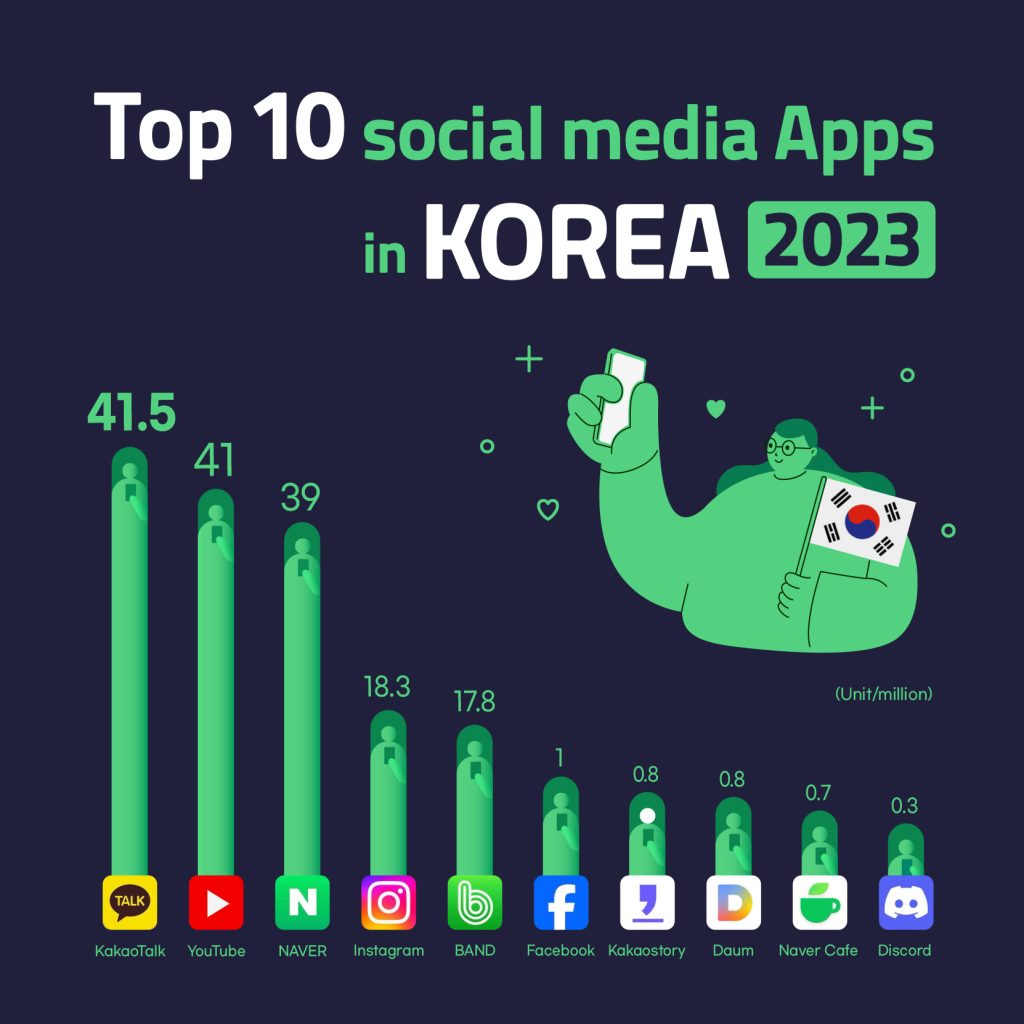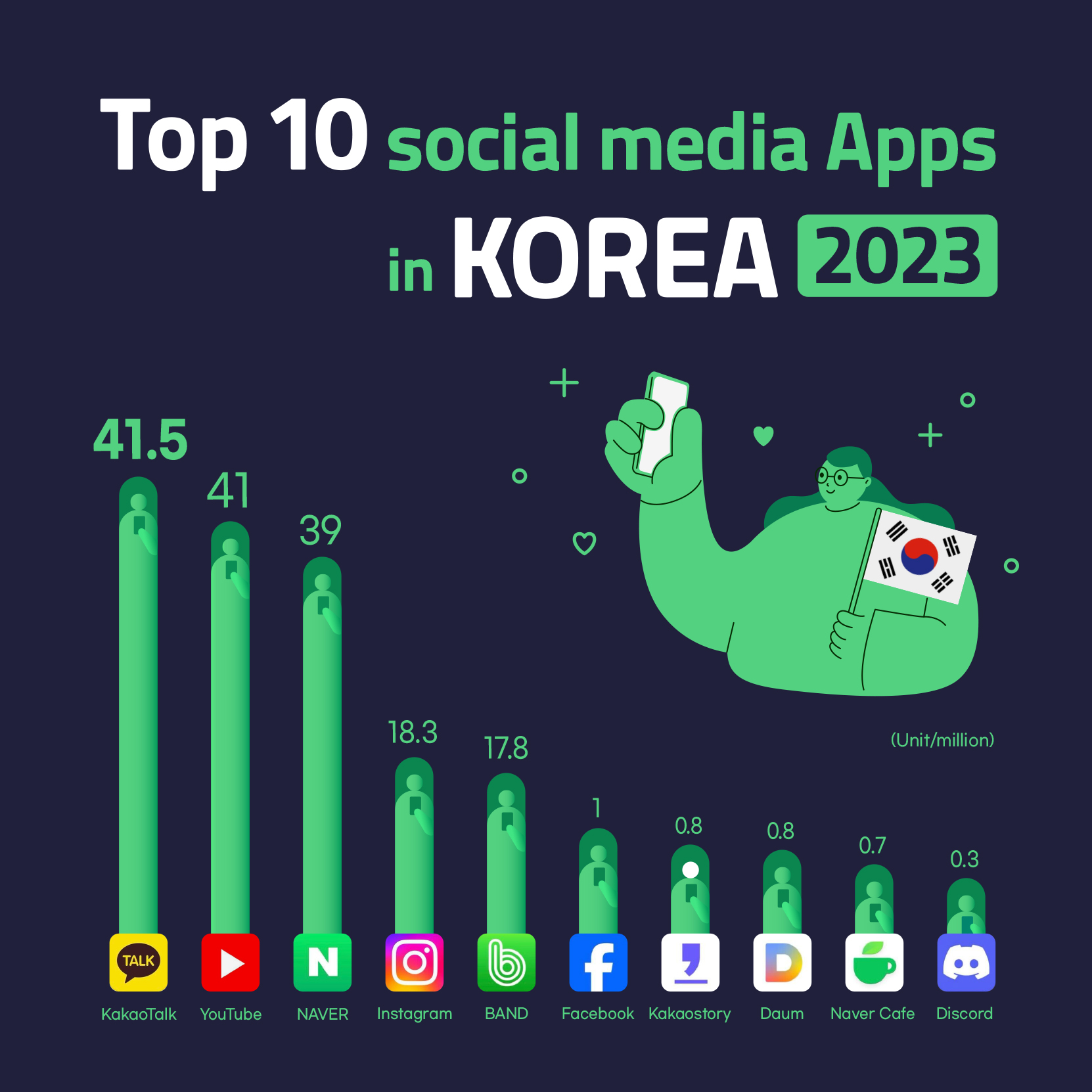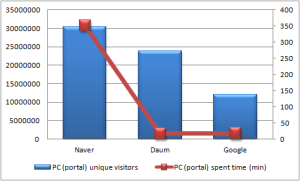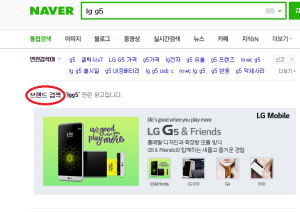Koreans are generally a social people and the “Active social network penetration in Korea” was 93%, the third highest in the world. Korea also has the world’s 6th highest smartphone penetration rate.
But what are the most popular social media apps in South Korea? There are different ways to measure this, for example:
- Most users
- Longest used
- Most often used
Every method ranks the top apps differently. We will share graphs and sources using the above 3 methods.
At the end of this blog post, we will share some anecdotes to show how social Koreans are offline.
1. Most users
Below are an infographic and a table of the top 10 apps with the number of users.

Source: https://www.madtimes.org/news/articleView.html?idxno=17956
| Rank | App name | # of users in million |
| 1 | KakaoTalk | 42 |
| 2 | YouTube | 41 |
| 3 | Naver | 39 |
| 4 | 18 | |
| 5 | Band | 18 |
| 6 | 1 | |
| 7 | KakaoStory | 1 |
| 8 | Daum | 0.8 |
| 9 | Naver Cafe | 0.7 |
| 10 | Discord | 0.4 |
Below is a short explanation of each Korean app.
- KakaoTalk: messaging app, but organizations can also make a “Channel” and post updates and send messages to followers. Similar to WhatsApp and WeChat.
- YouTube
- Naver: The Korean version of Google: has a search engine, blogs, communities and many more services.
- Band: Communication app for online communities, similar to Facebook Groups. Band was developed by Naver.
- KakaoStory: social network, but the number of users keeps declining and the demographic is old.
- Daum: Rival to Naver and owned by the company that also operates KakaoTalk.
- Naver Cafe: service that allows users to create their own open or closed online communities based on interests, similar to Facebook Groups or Reddit.
- Discord
Some apps are used more by younger people (Instagram) and other apps are used more by older people (Band and KakaoStory).
The number of Facebook users in Korea keeps declining. Korean Facebook users have shifted to Instagram.
2. Longest used
What were the apps that were used for the longest times? A table and chart is below.
| Rank | App | # of minutes used per month |
| 1 | YouTube | 998 |
| 2 | KakaoTalk | 340 |
| 3 | Naver | 226 |
| 4 | 158 | |
| 5 | TikTok | 75 |
| 6 | Naver Webtoon | 51 |
| 7 | Cashwalk | 49 |
| 8 | Netflix | 49 |
| 9 | TMAP | 48 |
| 10 | X (Twitter) | 44 |
Source: https://www.newsis.com/view/?id=NISX20231220_0002564787&cID=13006&pID=13100
It is assumed that YouTube Shorts is the reason why YouTube is the longest used app in Korea.
Instagram is used by all age groups, but more by younger people.
X / Twitter and TikTok are some of the most popular apps with Korean teenagers.
3. Most often used
What were the apps that were used the most often? A table and chart is below.
| Rank | App | Average monthly uses in billion |
| 1 | KakaoTalk | 75 |
| 2 | Naver | 15 |
| 3 | YouTube | 13 |
| 4 | 13 | |
| 5 | Cashwalk | 9 |
| 6 | Toss | 5 |
| 7 | X (Twitter) | 5 |
| 8 | Coupang | 3 |
| 9 | Carrot Market | 3 |
| 10 | Band | 3 |
Source: https://www.newsis.com/view/?id=NISX20231220_0002564787&cID=13006&pID=13100
Anecdotes
According to Hofstede’s cultural dimensions theory, Korea scores low on “Individualism” (high on collectivism). https://www.hofstede-insights.com/country-comparison-tool
Korea’s low score on the Individualism dimension indicates a collectivistic society. In collectivistic societies, individuals are expected to prioritize the goals of their group (whether this is their family, extended kin, or other in-groups) over their own personal goals. Here are some implications and observations about Korea based on its low Individualism (high Collectivism) score:
- Family and Work Group Orientation: In Korea, there is a strong emphasis on the family unit and work group. People have a strong sense of loyalty and responsibility to their family and the organizations they belong to. This can be seen in the workplace, where there is often a strong emphasis on harmony, teamwork, and group consensus.
- Interpersonal Relationships: Relationships and social networks are very important. Building trust and maintaining harmonious relationships are key to personal and business interactions. This can involve a significant amount of socializing, including after-work gatherings known as “회식”, which are seen as important for team bonding and networking.
- Communication Style: Communication tends to be indirect and seeks to maintain harmony and avoid conflict. The use of non-verbal cues is important, and understanding the context and the relationship between speakers is crucial. There is a strong emphasis on humility, respect for authority and elders, and understanding one’s role within the group.
- Decision Making: Decision-making processes in collectivist cultures like Korea’s tend to be more top-down, reflecting hierarchical social and organizational structures. However, there is also a strong emphasis on gaining group consensus to ensure that decisions are supported by the group, which can sometimes make decision-making processes appear slower to those from more individualistic cultures.
- Education and Competition: There is a high value placed on education as a means of achieving social mobility and bringing honor to the family. This can lead to highly competitive educational environments, as success is seen as a reflection on the individual’s family and in-groups.
- Social Welfare and Harmony: The well-being of the community and maintaining social harmony are considered more important than individual success. This can be seen in the strong support for social welfare systems and policies aimed at reducing social inequalities.







One Response